We got our hands on an HP ZBook Fury 17 G7. It's a slimmed-down 17 inch mobile workstation with an impressive maximum configuration. The minimum, maximum, and as-tested configurations are in our Quick Look article. Let's have a look at usability and performance here.
Maximum power in a shoulder bag
It weighs under 3 kg, but there is nothing light-weight about the Fury's power. A 4K DreamColor display, 10 TB of NVMe SSD storage, 128 GB of RAM, an 8-core Core i9, and last-but-not-least, a Quadro RTX 5000.
Doing Product Design and need realtime simulation? What about handling realistic renderings in A/E/C? Do you need to edit 4K & 8K video? Are you iterating through special effects day after day or running AI training workloads?
The ZBook Fury 17 G7's maximum configuration can handle all of these tasks where ever you happen to find yourself.
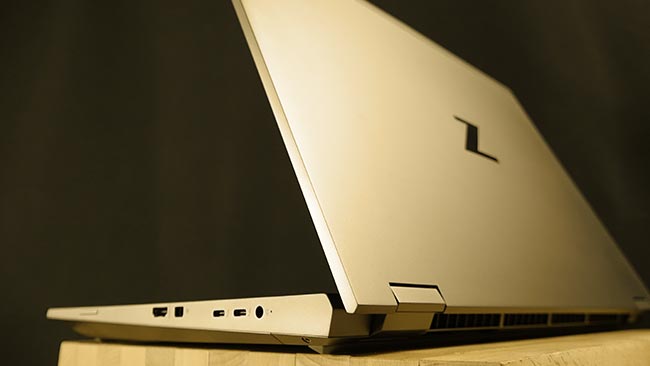
The HP ZBook Fury 17 delivers heavy-weight power in a 3 kg package
HP puts the 17 inch model on a diet - lose the fat, keep the muscle
Actually, HP put their 17 inch range on a diet and a workout program as well. There is plenty of muscle in this workstation. HP did not skimp on the power and capacity in the Fury model.
This ZBook is 29% smaller in volume than its predacessor - that's almost a one third reduction in size! Yet this 17 inch model is still full size and fully powered.
The available displays include a 4K 17.3 inch diagonal DreamColor display. The full sized keyboard includes a number pad. The large touchpad reserves space for mouse buttons at the top and the bottom of the touchpad.
And while you might want a docking station to make life in the office easy, it is unlikely that you will need to fill your travel bag with connectors.
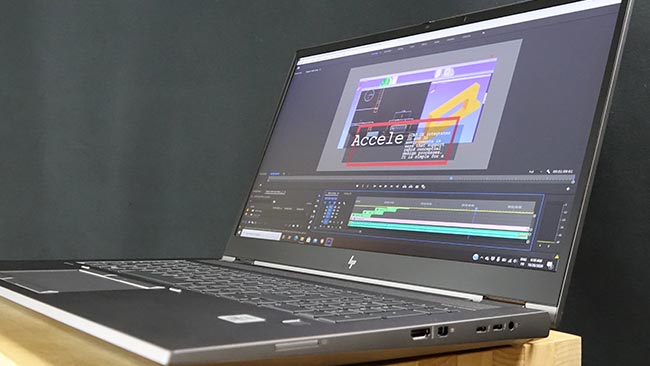
At its maximum configuration, the ZBook Fury 17 G7 is more powerful than many desktop workstations
HP’s DreamColor display option makes color-accurate workflows possible from creation to delivery of content regardless of the final deliverable format: print, digital, or film. For 4K or 8K video. Our test model came with a simple FHD display.
Artificial intelligence workflows need fast computing, especially GPU computing, and they leverage very large data sets. The ZBook Fury makes AI workflows possible through the combination of the Quadro RTX 5000, fast Intel eight-core processors, 128 GB of RAM and 10 TB of fast SSD storage.
How is the performance?
The test configuration was not, unfortunately, the maximum possible configuration. The main limitations related to benchmarking were the Core i7 CPU and the Quadro T2000 GPU. Secondary impacts might come from the limited 512 GB SSD storage in our test system.
That said, we were able to test the ZBook Fury against a mobile system with a similar CPU and a Quadro RTX 3000. This allows a peak at the benefits of going up one step in GPU power.
For us, the target configuration of any large road warrior mobile workstation like the ZBook Fury 17 should be the high end configuration. Why? If your workflow doesn't require one or more of the high capacity and high performance options that the Fury offers, then you would be well served by smaller, lighter ZBook model like the ZBook Studio G7.
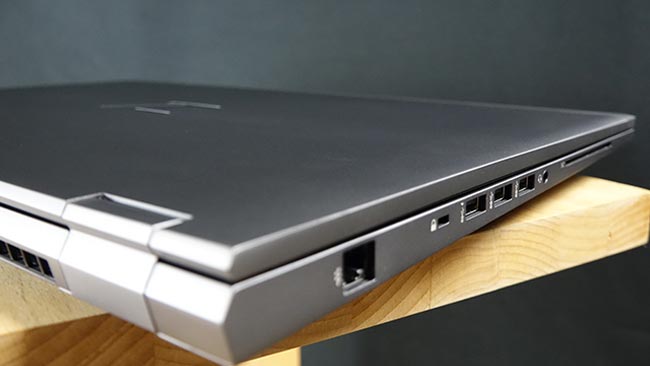
The ZBook Fury 17 G7 keeps you connected with plenty of ports and media formats
The performance results are compared to a mobile workstation with a very similar Core i7 processor and a Quadro RTX 3000 GPU that is one step up from the Quadro T2000. Both workstations use 16 GB of RAM and a fast SSD for storage.
Since the Fury G7 can also be configured with an RTX 3000, this comparison represents a real choice that you could face. The CPU paired with the Quadro RTX 3000 is a Core i7 which is clocked at just 100 MHz faster than our ZBook Fury. This is so close that the results can be easily compared.
Benchmarks
Our first set of benchmarks to look at are from SPEC.org. The standard is Viewperf 13. During our tests, the organization released the update, Viewperf 2020. We provide the results for both.
CPU performance has a minor effect on Viewperf results. GPU performance determines Viewperf results.
Additional benchmarks include Octane Bench for CUDA / GPU computing performance, Cinebench for GPU and CPU rendering performance, and Premiere Pro for video processing performance.
Open charts in a new tab to see full sized images.
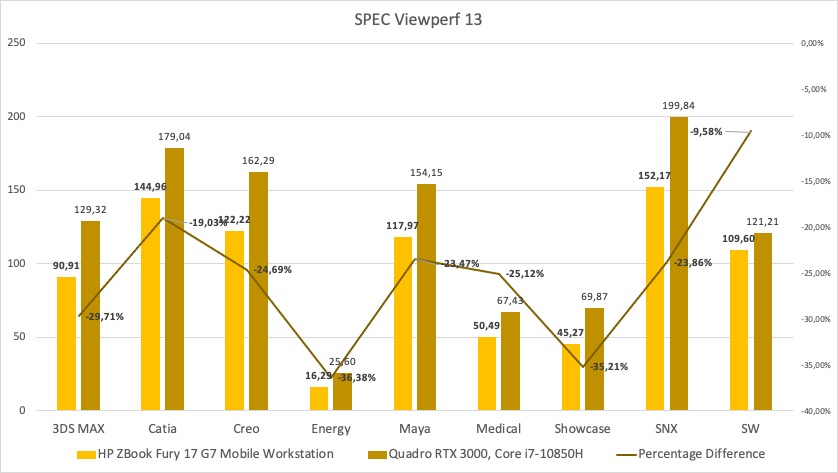
SPEC Viewperf 13 is the previous standard for workstation graphics benchmarking. Results are measured in frames per second (FPS) through a weighted average calculated for each data set. This testing shows that the smallest performance differences between the GPUs are in the CAD tests. These differences range from 10% to 25%.
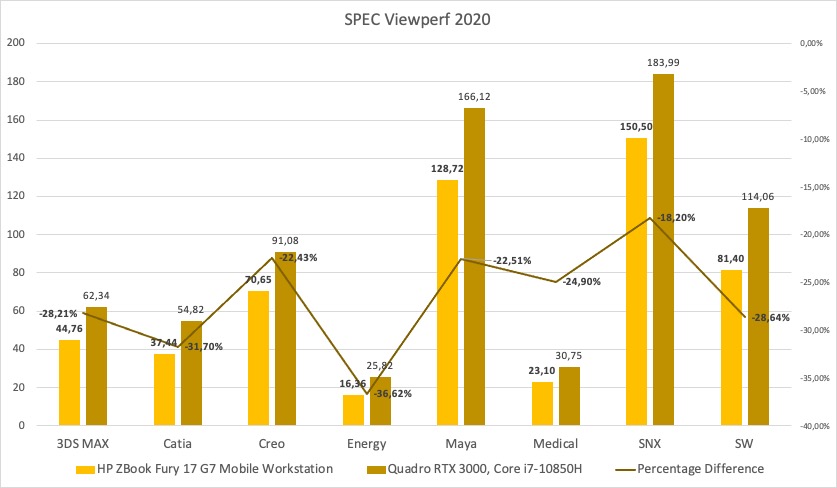
SPEC Viewperf 2020 was released during our testing and this is the first set of results we have published. The Showcase data set from Viewperf 13 has been dropped as the product is no longer supported by Autodesk. The remaining data sets have been updated and most of them have lower FPS results. In Viewperf 2020, the Energy data set remains the test with the highest performance advantage for the Quadro RTX 3000.

Octane Bench is a CUDA-based rendering benchmark. Although it is very specific, it is also very useful to demonstrate GPU computing performance differences. Even if your application is not photorealistic rendering, Octane Bench clearly shows relevant differences in GPU computing performance for NVIDIA GPUs.

Cinebench 15 results for GPU performance and CPU performance give a 14% edge to the faster Quadro RTX 3000 and a 6% edge to the slightly faster Core i7. The benchmark takes a more traditional approach to GPU graphics and CPU rendering performance. As such, it is a good tool for comparing GPUs and CPUs from different vendors.

The primary application test uses Premiere Pro CC. The majority of the performance difference can be seen in the relative difference in GPU performance. Lower scores are better in these results. These rendering test result are normalized to a percentage of real time playback. A result under 100% means that the rendering output is finished in less time than the duration of the video sequence.
A Final Perspective
The HP ZBook Fury 17 G7 is a powerful mobile workstation. Its expandability and high end performance should tempt any power-user who needs mobility. The basic configuration, and even our tested configuration, is not interesting to the real target customer of an HP ZBook Fury 17 G7.
That changes when we look at the high end configuration. Whether your performance priorities target the display, memory, storage, processor, or graphics, the high-end configuration offers a mouth-watering mix of technologies and features.
If you are a power user working from home or out on the road, the HP ZBook Fury 17 G7 can get the job done.
Check out the reviews for each system:
Affordable, mobile performance. HP ZBook Power G8
HP ZBook Studio G8 – the lightest & “coolest" mobile workstation
No-holds-barred mobile workstation performance: HP’s ZBook Fury G8
How they stack up. Comparing the ZBook Power, ZBook Studio, and ZBook Fury G8
And HP’s view of mobile computing:
Last Year, This Year, and Beyond – mobile workstation trends at HP
As well as the HP ZBook Family overview:
Z By HP – The Z Mobile Workstations
And for the data center, the ZCentral 4R workstation:
The workstation you needed last year is the workstation you will need next year






